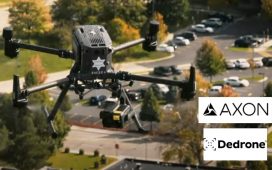Google on Wednesday revealed its Pixel 8 and Pixel 8 Pro model Android phones, and promised to support them in sickness and in health for seven years.
But at the mega-corp’s launch event, Rick Osterloh, VP of devices and services at Google, did not immediately introduce the devices as phones. He initially called them “the next evolution of AI in your hand,” before falling back on more traditional device-focused terminology.
“Our latest phones bring together so many technologies from across Google,” he said. “They’re the first phones to use our latest Google Tensor chip. They include the very best Android experience, first of their kind camera experiences, and the latest AI advancements from Google.”
The Pixel 8 starts at $699, with availability expected by October 12, in Rose, Hazel and Obsidian (pinkish, grey and black) case colors. Based around a 4nm Google Tensor G3 processor and a Titan M2 security coprocessor, the phone comes with 8GB LPDDR5X RAM and either 128GB or 256GB of UFS 3.1 storage. It has a Li-Ion 4,575 mAh non-removable battery, a 6.2-inch 1080-by-2400-pixel touchscreen, Wi-Fi 7, 5G, and the other usual bits and pieces.
The G3 is a nine-core 64-bit system-on-chip: there’s a large Arm Cortex-X3 running at 3GHz for demanding tasks, four Arm Cortex-A715s at 2.4GHz for general work, and four little, more battery friendly Arm Cortex-A510s at 1.7GHz, plus an Arm Immortalis-G715 GPU. It’s the typical thing: the bigger cores handle larger workloads on demand in bursts, while the smaller, more power efficient cores do the background and simple stuff, so that the battery lasts longer and the whole thing doesn’t overheat.
The Pixel 8 sports two rear-facing cameras: 50 MP Octa PD wide camera (ƒ/1.68 aperture) and 12 MP ultrawide camera with autofocus (ƒ/2.2 aperture). And a front-facing camera capable of 10.5 MP Dual PD selfie camera (ƒ/2.2 aperture).
The Pixel 8 Pro starts at $999, and also ships on October 12, in colors called Porcelain, Bay and Obsidian (white, light blue, and black). It also has a Tensor G3 and Titan M2 security chip, but comes with more memory (12GB LPDDR5X RAM) and a wider range of storage options (128GB, 256GB, 512GB, or 1TB of UFS 3.1 storage). It also has a larger 6.7-inch screen with a 1344-by-2992 pixel resolution.
In terms of rear-facing cameras, the Pixel 8 Pro has the 50 MP Octa PD wide camera but drops the 12 MP camera in favor of two others camera: 48 MP Quad PD ultrawide camera with autofocus (ƒ/1.95 aperture) and 48 MP Quad PD telephoto camera (ƒ/2.8 aperture). It has a Li-Ion 5,050 mAh non-removable battery, 5G, Wi-Fi 7, USB-C, etc, etc.
But the Pixel clearly is not about hardware specifications, Google was keen to stress. As Brian Rakowski, VP of product management put it in the company’s announcement, the Pixel 8 and Pixel 8 Pro are “engineered by Google and built with AI at the center for a more helpful and personal experience.”
Monika Gupta, program manager at Google, said, “Pixel 8’s AI experience starts right in the silicon,” as she talked up the Tensor G3 chip. “It’s our latest SoC designed specifically to bring Google’s AI breakthroughs directly to Pixel users, and show the world what’s possible.”
Attention of course was paid to device design, but it’s clear Google sees Pixel as a vessel for delivering AI services. “Pixel’s machine learning isn’t just for speech and photos anymore,” Gupta elaborated. “ML models now enhance just about every aspect of Pixel’s user experience.”
In practical terms, that translates into features like Pixel 8’s ability to transcribe messages as you speak, even if you switch between languages, and to read web pages aloud, in the written language or a different one, using the same text-to-speech model that Google uses in its data centers.
Google’s AI special sauce also supports the Pixel’s Call Assist feature, Clear Calling background noise removal, and Call Screen – an AI assistant that queries callers and lets through those deemed legitimate.
And of course various image processing options like Best Take and Magic Editor rely on AI – OK, it’s just software, but it’s more declarative (specifying a result) than imperative (manually applying filters and making edits), Google promised.
As well as hardware, Google has also emitted Android 14, which the Pixel 8 range will run. We’re promised that the OS gives you “control over your health, security and data.” More details on how to get it are here.
Despite Google’s gushing about AI everywhere, the Chocolate Factory is also doing right by its hardware, promising seven years of support – operating system updates, security updates, and Feature Drops.
“No major smartphone brand offers this committed level of support and longevity,” said Seang Chau, VP of engineering, and Shenaz Zack, director of product management, in a statement. “This makes these phones a more sustainable smartphone choice, because they’ll be secure and perform well for seven years.”
It appears sustainability is being taken more seriously in the tech sector. Google recently extended its Chromebook support period to a decade, at the urging of schools and repair advocates.
In addition to AI services wrapped in mobile phones, Google announced its latest smartwatch, Pixel Watch 2 ( $349 for Bluetooth/Wi-Fi, and $399 for 4G LTE), and refreshed earbuds called Pixel Buds Pro ($199.99). These also will be available on October 12. ®






